March 21, 2025 [Hydrogen Fuel News]- Europe’s Largest Electrolyzer Unveiled, Paving the Way for Green Hydrogen Revolution
Breaking Ground in Green Hydrogen Production
A major milestone in clean energy innovation unfolded this week as BASF, in partnership with Siemens Energy, unveiled Europe’s largest Proton Exchange Membrane (PEM) electrolyzer at its Ludwigshafen site in Germany. With the capability to churn out up to 8,000 tons of green hydrogen annually, this state-of-the-art, 54-megawatt powerhouse is designed to reshape industrial hydrogen production while slashing carbon emissions.
At full tilt, the electrolyzer can generate one metric ton of hydrogen per hour, playing a critical role in replacing conventional grey hydrogen with its green, low-emission alternative. Integrated into BASF’s existing production network, the new system promises not only to decarbonize chemical output but also powers the company closer to its ambitious net-zero objectives.
Electrolyzer Technology in Action
The heart of this breakthrough is the PEM electrolyzer technology, a game-changer in green hydrogen production. Unlike traditional processes fueled by fossil resources, PEM electrolyzers use electricity sourced from renewables to split water into hydrogen and oxygen, making the entire operation emissions-free. What gives BASF’s electrolyzer its edge is its modular design featuring 72 interconnected stacks, which allows for seamless integration into the Ludwigshafen plant’s existing infrastructure.
From here, the hydrogen produced will be fed into the site’s Verbund network, supplying essential raw material for manufacturing ammonia, methanol, vitamins, and other chemical products. But it doesn’t stop there. This green hydrogen will also support clean mobility initiatives in the Rhine-Neckar Metropolitan Region, marking an important step towards building a robust hydrogen economy.
From Vision to Reality with Significant Backing
Such a landmark achievement in the energy transition wouldn’t have been possible without a robust financial injection. The project garnered €124.3 million in funding from the German Federal Ministry for Economic Affairs and Climate Action, as well as the State of Rhineland-Palatinate. This underscores the critical role that government support plays in driving forward pioneering technologies that tackle climate change head-on.
Katrin Eder, State Minister for Climate Protection, Environment, Energy, and Mobility in Rhineland-Palatinate, called the electrolyzer “a significant milestone in the region’s climate protection targets.” She highlighted its dual impact in scaling up renewable raw material usage and slashing reliance on natural gas. For BASF, this isn’t just a feather in the cap; it’s the bottom line of a much larger sustainability ethos.
Why This Electrolyzer Matters for the Energy Transition
Now, you might be wondering, beyond reducing emissions for a single company, what tangible impact does this project have for broader energy markets? The answer lies in its ripple effect.
Green hydrogen represents a vital pillar of the global energy transition. It offers industries a pathway to decarbonization in sectors where electrification alone isn’t enough. Heavy industries like chemicals, steel production, and even shipping can’t easily swap out their processes for purely renewable electricity. This is where green hydrogen steps in as a clean, versatile alternative.
BASF’s electrolyzer sets an important precedent. It demonstrates how partnerships between industrial giants and energy innovators can tackle entrenched reliance on high-emission energy inputs. By displacing grey hydrogen on this scale, the project not only cuts BASF’s carbon footprint but raises the bar for the entire hydrogen economy across Europe.
Furthermore, the operation is expected to reduce greenhouse gas emissions by a staggering 72,000 metric tons annually. To put it in perspective, this is roughly equivalent to taking around 15,000 passenger vehicles off the road each year.
The Global Implications and Technological Advances
With the International Energy Agency (IEA) advocating for a tenfold increase in global hydrogen use by 2050, projects like this one aren’t just important—they’re essential. The BASF electrolyzer illustrates how evolving PEM technology can rise to meet this demand, offering scalable solutions that dramatically improve efficiency, reduce costs, and reduce deployment timelines.
Industry analysts predict that such advancements will help accelerate green hydrogen’s penetration into international energy markets. Countries working towards net-zero goals will increasingly look to replicate projects like Ludwigshafen, leveraging their lessons to build a resilient hydrogen economy.
The conversation doesn’t lose sight of ongoing hurdles, though. Despite its merits, green hydrogen production remains energy-intensive, and its cost competitiveness relies heavily on the widespread availability of cheap renewable electricity. These challenges make innovation in hydrogen production and policy support coordinated across borders crucial to making it a viable long-term option.
A Balanced Step into the Future
The unveiling of Europe’s largest electrolyzer is undoubtedly a pioneering feat, blending advanced technology with large-scale strategic thinking. It reflects the sort of bold action needed to combat carbon-intensive industrial practices, sending a hopeful signal to global clean energy advocates.
But while it’s tempting to celebrate this as a standalone success, projects like this are a launchpad, not a finish line. To deliver lasting change, the industry must continue evolving and expanding its reach to other sectors, regions, and setups. For BASF, this electrolyzer is one piece of a larger sustainability puzzle. For the rest of the industry, it’s a clear nudge to follow suit.
Hydrogen has long been touted as the fuel of the future. With strides like this, it’s finally starting to feel like the future is catching up. The path ahead may be steep, but it’s illuminated by the glow of innovation and the undeniable urgency of our global energy needs. And really, isn’t that the spark we’ve all been waiting for?
Free Trial: Access 13,300 Tank Terminal and Production Facilities
13,300 tank storage and production facilities as per the date of this article. Click on the button and register to get instant access to actionable tank storage industry data
Hydrogen Fuel News











